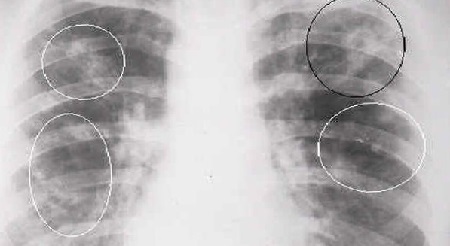With age, changes occur in the human body that affect different organs and systems, including medium and large arteries.
As a result, serious diseases and pathologies begin to develop that can lead to the most unfortunate consequences and even death. One of these diseases is called giant cell arteritis.
General Information
 Giant cell arteritis( alternative names - Horton's syndrome, Horton's disease) is an inflammatory disease of the middle and large arteries. In their walls, begins the process of accumulation of abnormal giant cells , which eventually seizes new and new sites.
Giant cell arteritis( alternative names - Horton's syndrome, Horton's disease) is an inflammatory disease of the middle and large arteries. In their walls, begins the process of accumulation of abnormal giant cells , which eventually seizes new and new sites.
There is thickening of the arterial membranes, narrowing of the lumens of the vessels and the formation of the parietal thrombi, which disturb the blood flow in the lesions until it is completely stopped.
The disease can cover any arteries of , but most often the affected are the carotid, cranial and temporal( temporal arteritis is most common).Occasionally, the veins are involved in the inflammatory process.Causes of
The causes of Horton's disease are not fully understood, but most experts agree that its main causes are immune disorders, characterized by the prevalence of viruses and bacteria in the lesions of .Often the disease is preceded by mycoplasmal, parvoviral and chlamydial infections.
 After getting pathogenic microorganisms into the body, they begin to actively develop antibodies to immunity, provoking autoimmune inflammation of .It negatively affects the functioning of the circulatory system, leads to a narrowing of the lumens of the arteries, a violation of blood flow and oxygen starvation of the cells.
After getting pathogenic microorganisms into the body, they begin to actively develop antibodies to immunity, provoking autoimmune inflammation of .It negatively affects the functioning of the circulatory system, leads to a narrowing of the lumens of the arteries, a violation of blood flow and oxygen starvation of the cells.
To the factors provoking the development of giant cell arteritis, also include tuberculosis, influenza and hepatitis virus .The presence of a hereditary and genetic predisposition is not excluded: many patients carry carriers of A10, B14, HLA and B8 genes.
Species and Forms of
Depending on the location and pathogenesis of , Horton's disease is conditionally divided into the following types:
- localized giant cell arteritis only applies to one group of vessels;
- rheumatic polymyalgia , characterized by extensive inflammatory process;
- is an extensive giant cell arteritis , which combines temporal arteritis and rheumatic polymyalgia;
- lesions the large arteries of the organism.
The nature of lesions in the development of the disease is segmental and focal .In the first case, it affects individual structures, and in the second there is a mass violation of the integrity of the vessels.
The dangers and complications of
The danger of giant cell arteritis is that the damage to the arteries often goes unnoticed, which causes the risk of complications. The most common of these is the lesion of the arteries of the eyes, leading to partial or total blindness of the .Complications also include strokes and heart attacks, which can develop against the background of the overall picture of the disease.
Symptoms of
Among the symptoms of Horton's disease are common and vascular symptoms, as well as damage to the organs of vision.
General symptoms:

- prolonged or episodic temperature increase up to 38-39 ° C, fever;
- absence of pulse in peripheral arteries;
- frequent headaches, which can occur even when combing the hair;
- uncomfortable sensations in the face: pain, tingling, burning, numbness in eating or talking;
- lack of appetite, fatigue, weakness, weight loss;
- sleep disorders, irritability, depression;
- dull pain in the muscles and joints.
Vascular symptoms:
- compaction, tenderness and redness of the arteries( temporal, parietal, etc.);
- appearance of nodules on the scalp;
- in the defeat of other major arteries, the symptoms characteristic of the pathological process: lameness, strokes, myocardial infarction and other organs.
It is not difficult to recognize the triggered temporal arteritis - the vessels are enlarged, as in this photo:

Eye lesions:
- blurred vision: sensation of "flies" and "fog" before the eyes;
- descent of the upper eyelid;
- diplopia( double vision);
- pain in the eye area.
When should I see a doctor?
To avoid the development of dangerous complications, the patient should consult a doctor even with the slightest suspicion of Horton's disease : chronic pain in the head and face, constant fatigue, frequent body temperature rises, etc.
The rheumatologist is engaged in the treatment of pathology, which should listen carefully to the patient's complaints and prescribe additional studies.
 See also the disease of nodular periarteritis, its photos and symptoms - it is better to know all this in advance, in order to get medical help on time.
See also the disease of nodular periarteritis, its photos and symptoms - it is better to know all this in advance, in order to get medical help on time. On the diagnosis and treatment of Takayasu syndrome, the characteristic symptom of which is the absence of a pulse, read here.
It is equally important to know in advance everything about Raynaud's disease: its diagnosis, symptoms and treatment. All here.
Diagnosis
The identification of giant cell arteritis is complicated by the fact that it has a symptom similar to other diseases. The diagnosis is based on the following analyzes and studies:

- General and biochemical blood test .In patients, there is a sharp increase in ESR accompanied by mild anemia and persistent or episodic fever, as well as hyper-alpha and gamma globulinemia.
- External inspection of the .Includes palpation of the arteries and veins, which in the presence of the disease can be densified, swollen or painful.
- Biopsy of the temporal artery .Under local anesthesia, the patient is taken a section of the temporal artery tissue, which is then carefully examined under a microscope to identify the infected cells. The method allows to confirm or deny the presence of the disease with almost 100% probability.
- Angiography of the .The procedure for radiographic examination of arteries and veins, which makes it possible to determine the site of narrowing and the extent of the spread of the inflammatory process.
- Ophthalmoscopy .A study of the organs of vision with which help in patients with giant cell arteritis can reveal the development of ischemic neuritis of the optic nerve and other complications.
Treatment of
After the diagnosis, the patient is given high doses of corticosteroids, and is especially effective in the drug called Prednisolone.
Treatment is recommended to continue for about a month, after which the dose is gradually reduced in such a way that the therapy was canceled in 10-12 months.
After a reduction in the dose, the patient should be under the constant supervision of the attending physician, since any abnormalities indicate a relapse of the disease. In this case, there is a certain number of people who have to take Prednisolone in a maintenance dosage for several years.
 Approximately in 10% of cases, high doses of "Prednisolone" do not give the expected effect of , so patients are prescribed a three-day therapy with "Methylprednisolone" intravenously, after which they switch to oral medication. This tactic is especially effective when a person develops eye pathologies.
Approximately in 10% of cases, high doses of "Prednisolone" do not give the expected effect of , so patients are prescribed a three-day therapy with "Methylprednisolone" intravenously, after which they switch to oral medication. This tactic is especially effective when a person develops eye pathologies.
Hormone therapy is currently considered the only way to treat , which can quickly suppress the symptoms and manifestations of giant cell arteritis. The effectiveness of other methods has not yet been confirmed.
Learn more about the temporal and other forms of Horton's disease from this video:
 And do you know what stenosis is in the aorta's mouth and how does it manifest itself? Make sure that you do not have any of his symptoms.
And do you know what stenosis is in the aorta's mouth and how does it manifest itself? Make sure that you do not have any of his symptoms. You can find out about the causes and signs of aortic dissection from this publication.
Than the obliterating thromboangiitis of the lower extremities is dangerous and how to treat it - find out by clicking here.
Prevention
Since the causes of Horton's disease have not yet been clarified, recommends general measures to strengthen the body ( healthy lifestyle, avoiding bad habits, moderate physical activity) as well as timely treatment of infectious diseases.
Patients who are diagnosed with "giant cell arteritis" are confirmed, it is important to understand that the disease is classified as a chronic , and therefore requires appropriate preventive measures throughout life.
According to studies and practical observations, the elderly age of can be considered the main risk factor for the development of Horton's disease. People who have crossed the 50-year threshold should pay close attention to their health and remember that timely diagnostics and adequate treatment of the disease can lead to persistent and prolonged remission.



